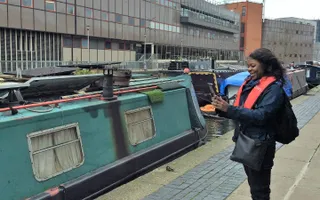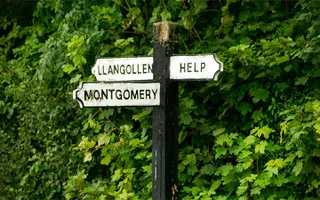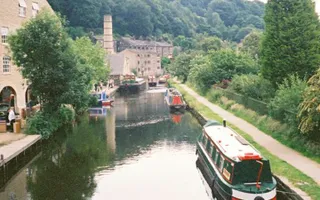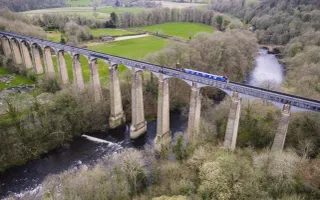As part of having any kind of boat licence, all boats need to move every 14 days (or sooner, depending on the mooring sign), unless you’re on your home mooring.
Recording all boat movements
Have you met one of our local monitoring teams or rangers on the towpaths?
They monitor all boat movements (not just continuous cruisers) and help to make sure everyone keeps to their licence terms and conditions. When our team record the location of a boat, they mark which kilometre of waterway it's on.
Boat sightings on my web licensing account FAQs
Customers can now see their recorded boat sightings on their web licensing customer account. Below are some frequently asked questions we hope will help.
How do you take sightings?
We have a team of licensing rangers who record sightings of all the boats across our 2,000-mile network. We aim to cover the whole network at least every 14 days. We also have other colleagues, including mooring rangers and volunteers, who support us by taking additional boat sightings. The details of boats are input into a tablet and uploaded to our system, where the sightings are recorded against each boat.
What is a Functional Location (Floc)?
We use functional locations to identify each kilometre of our network. A Floc is made up of two letters denoting the waterway, followed by three numbers, which denote the kilometre length on that waterway. Some Flocs will include a second set of three numbers, which indicate a specific feature on the kilometre length.
For example, a mooring site on the 50th kilometre of the Grand Union Canal may look like this:
GU-050-011.
If your boat is sighted when not at a recorded feature, the Floc will only contain the first set of three numbers, for example, on the 106th kilometre of the Kennet & Avon Canal: KA-106.
How can I find where a Functional Location (Floc) is?
Our interactive map allows you to search by inputting your Floc. This will show you where a particular Floc is. If you know a location and want to find out its Floc, you can search by place name or zoom in on the map. Clicking/tapping on the canal or any features (bridges, locks, etc.) will show you the Floc number.
Can I see all my sightings?
You can see sightings since the boat has been allocated to your Web Licensing account. We will delete data once no longer required for the purpose it was collected.
Because licences are issued monthly, you will not be able to see sightings from the last 28 days. This ensures that a previous owner’s data is not shared with a new owner in the event of a change of ownership mid-month. These sightings will become available after 28 days on a rolling basis.
Please do not contact us to request the first month’s sightings, as the time taken to provide them will exceed the time in which they are available on your web licensing account.
What do I do if there are missing sightings?
Our sightings are taken regularly and reliably, but because of boat movement and the schedule our rangers maintain, we sometimes miss each other. This is nothing to be concerned about, as we don’t expect to capture all movements. We are only concerned with the overall boat movement pattern over longer periods of time.
We do not need to know about missed sightings unless you have received an overstay reminder, which is a result of a missed sighting. Although rare, this can happen if a boat has moved to a different point over the last week or so and then turned back on itself, stopping in the same area as before on the way to a destination in the opposite direction. If this happens, just let our licensing team know, and we can withdraw the reminder.
We are unable to take customer-provided boat sightings regularly, and doing so may be in breach of GDPR UK as the data might be excessive for the Trust’s processes. However, if we have missed sightings that would alter the outcome of a decision regarding licensing as a continuous cruiser, we can update your record when you provide us with the details of a missed sighting with the appropriate evidence (see 'How should I log my cruising?'). We would only need to do this in the rare event that the missed sightings would have altered the outcome of a decision on licensing.
What if there’s a sighting I don’t recognise?
Don’t worry straight away! We may not use the same names for mooring sites or bridges as are used locally. Check the sighting against our interactive map to see if it is correct. This should resolve most concerns.
On occasion, there may be an error at the point of the sighting being captured. This is rare, but our rangers are human, and sometimes mistakes happen. If this is the case, we’re sorry and will spot the incorrect sighting in our review process and mark it accordingly. You do not need to take any action.
If you still have concerns, or are seeing repeated or numerous incorrect sightings, please contact the licensing team.
How should I log my cruising?
We recommend that all boaters, particularly continuous cruisers, maintain a cruising log. This helps if there is ever any concern about our sightings.
A cruising log should record the locations where you moor your boat and should be evidenced by photographs with date and location data. Most smartphones allow you to record the location and date information within the photograph file. You may need to turn on location data in your camera settings (for Android, turn on 'add location' in camera settings. For iPhone, open the settings app, select 'Privacy', 'Location Services', and then 'Camera', allowing location settings 'whilst using the app').
If you have a digital camera or do not want to turn on location settings on your smartphone, please take photos showing the boat at an identifiable location, for example, a local landmark or Canal & River Trust signage. Date stamps can be included on digital camera photographs in the camera’s settings.
We may accept other documentary evidence of cruising, but only if we are satisfied with its suitability. Invoices or receipts that put a boat in a place at a time can be helpful, for example, mooring invoices, boat yard receipts, or receipts for large fuel refills.
Without evidence to support a written cruising log, we may not accept any additional cruising recorded in it.
You do not need to provide us with additional sighting information unless a problem emerges, for example, a dispute over a licensing decision. If you need to provide us with additional sighting information, please contact the licensing team.
What if I can’t access my Web Licensing account sightings?
If you cannot access your sightings data, please contact our team by email at [email protected] or our customer service team on 0303 040 4040. It is important that you let the team know that you cannot access your sightings so they can provide them in a different way.
Continuous cruising monitoring process
Early in 2015, we introduced a new process to monitor the movement of boats without a home mooring (continuous cruisers). Here you'll find some information about how we monitor these boat movements, why we have to do it, and what it might mean for you:
What happens if boats don't move on?
If our boat licensing, compliance and enforcement team record that a boat hasn't moved after 14 days (or less, depending on the visitor sign), whether they're on a visitor mooring or mooring on the towpath, we'll send that boater a 'reminder' letter asking them to either continue their journey or to get in touch with our team if there's a problem preventing them from continuing their journey.








